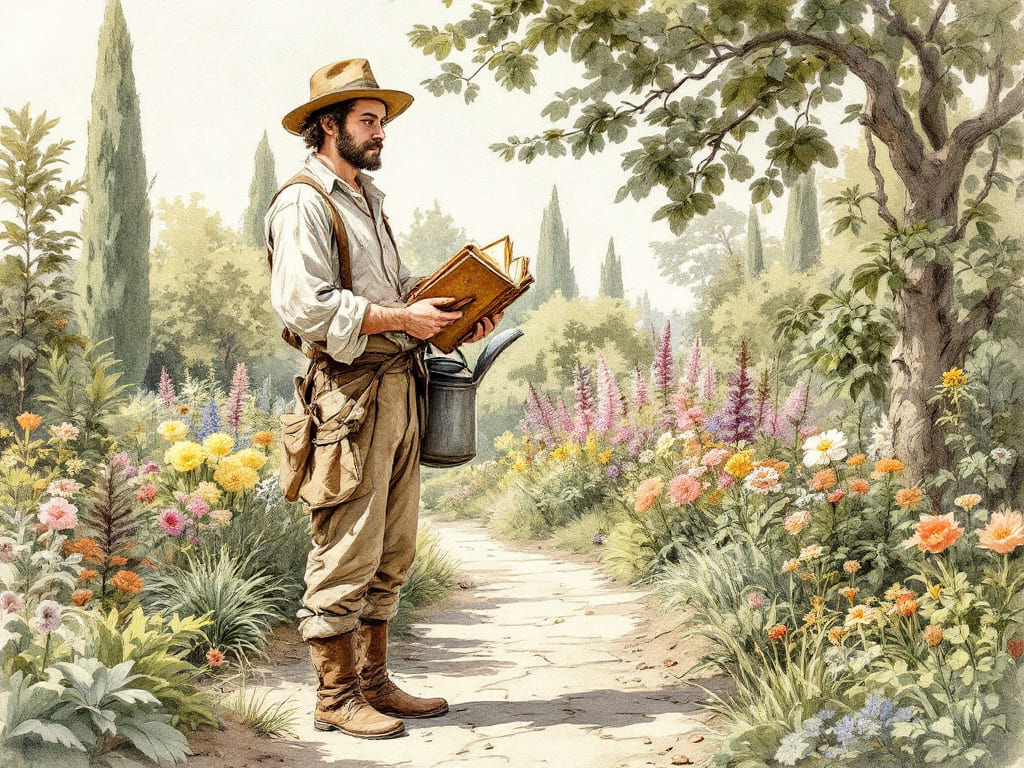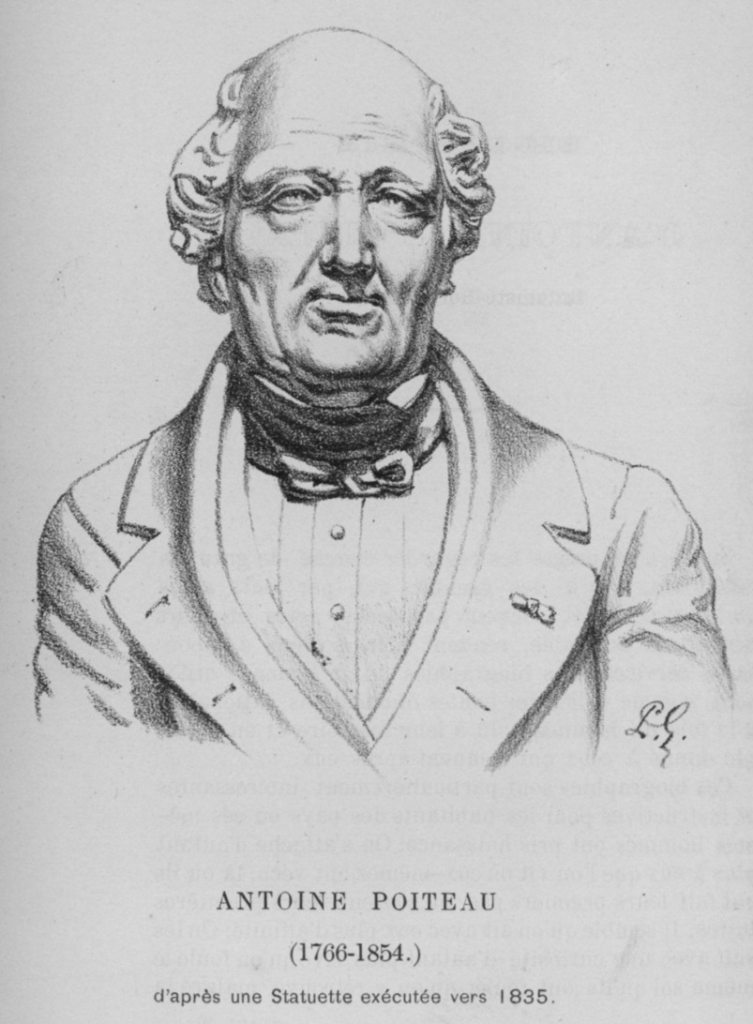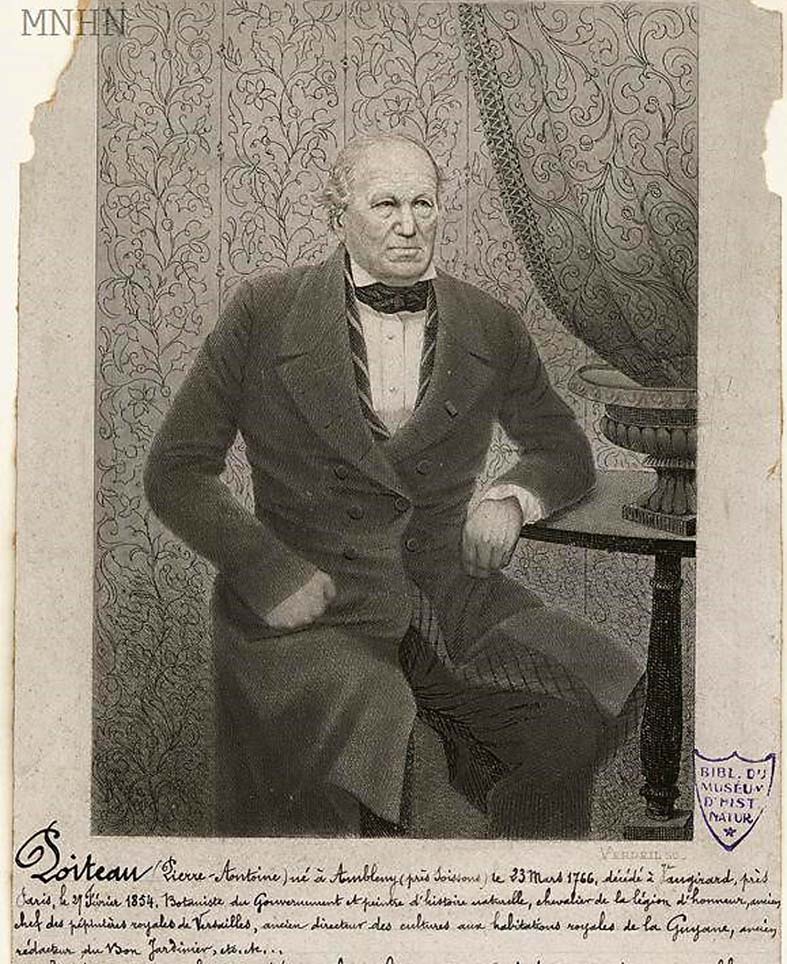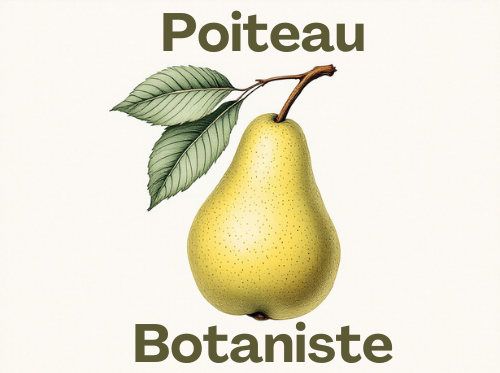🍃A life dedicated to botany, from the humble cottage to the royal gardens
Birth and Childhood: Pierre-Antoine Poiteau was born on March 23, 1766, in Ambleny, near Soissons. Coming from a modest background, his parents, Antoine and Marie-Jeanne Blanchard, were simple laborers, illiterate and penniless. His father worked as a carter and then as a barn thresher. The family left Ambleny two years after his birth to settle in Vivières, near Villers-Cotterêts.
Education and first steps in the world of work: At the age of six, Pierre-Antoine Poiteau was sent to school in Viviers, where he learned the basics of reading and writing. He became an altar boy at the age of nine. However, at the age of twelve, he was forced to work in the barn, a job too arduous for him. He then held various jobs, including lemonade boy and barn thresher, before finding his way in horticulture.
📜 Anecdote: He admits to having “a good enough memory to repeat lessons by heart, as some little girls did so delightfully.”
He was also confronted with the popular belief in witches and werewolves, a revealing element of his background.
He learned grammar at the age of 24.
🌿 The awakening of a passion for botany
His career led him to work as an apprentice gardener in a convent, then as a gardener in various locations. It was through contact with nature that he developed his passion for horticulture.
After a two-year stay at the convent of Saint Remy and three years as a gardener for a widowed Musard in Villers-Cotterêts, Pierre-Antoine Poiteau came to Paris to try his luck for the first time at the age of 19.
He was unable to find work and was forced to return to Villers-Cotterêts.
At the age of 22, he returned to Paris again, and this time, he managed to find a job with a market gardener.
😲 Anecdote: During his stay in Paris, he witnessed the events of the French Revolution. While working for a market gardener, Poiteau and his boss found themselves drawn into the crowds heading towards the Bastille on July 14, 1789. They each had a pitchfork on their shoulder, which made them appear to be combatants.
However, Poiteau specifies that he was not motivated by a warlike spirit or political ardor. He says: “Fortunately, when we arrived near the Bastille, it had just been taken. We did not have to participate in the struggle.” He notes that others, less reserved and less modest, did not hesitate to give themselves the title of combatants and victors of the Bastille, thus attributing to themselves the honor and profits of this event.
During the winter of 1789 and 1790, and as his employer did not keep him on during the winter period, Pierre-Antoine Poiteau worked as a mirror polisher in the royal factory in the Faubourg Saint-Antoine.
Rise to the Jardin des Plantes: In 1790, Poiteau was hired as a “gardener’s boy” at the Jardin des Plantes in Paris. His talents were quickly noticed by his employers, who provided him with excellent training as a botanist.
📖 Poiteau’s apprenticeship at the Museum: a thirst for knowledge and extraordinary determination
Pierre-Antoine Poiteau had neither academic training nor institutional support, but an unwavering will. His time at the National Museum of Natural History was a true self-taught journey, forged through hard work and passion.
A determined autodidact : Unable to write or express himself correctly in French, he imposed upon himself a rigorous apprenticeship in grammar, achieving an enviable level of mastery. He also studied Latin, an essential key to understanding the botanical treatises of Linnaeus and Murray, going so far as to revise while working the land.

Pierre-Antoine Poiteau continuing his theoretical training while maintaining the plants at the Jardin des Plantes in Paris. (Illustration)
A complete scientific and artistic training : Poiteau followed Desfontaines ‘ botany courses, memorizing more than 200 generic characters in one year and assimilating plant classifications with remarkable ease.
Aware of the importance of scientific illustrations, he also trained in
drawing and painting under the direction of Gérard van Spaendonck and inspired by the works of Pierre-Joseph Redouté .
He then became Desfontaines ‘ lesson preparer and was recognized for his skills.
🧭 Botanical missions and explorations:
- Saint-Domingue (1796-1801): In 1796, André Thouin sent him to Saint-Domingue to study the local flora. Despite revolutionary unrest and logistical difficulties, he collected 1,200 species of plants and 600 packets of seeds. There, he met Pierre Jean François Turpin, with whom he would collaborate as a designer.
- He stayed in particular in Cape Town, Turtle Island, Jacmel and Santo Domingo.
- He sent the Museum 289 species of seeds collected in Santo Domingo.
- French Guiana (1818-1821): In 1818, Pierre-Antoine Poiteau was appointed “botanist to the king” in French Guiana . He developed crops there despite strong administrative resistance. His return to France was difficult.
- His places of stay include Cayenne and the Habitation des Épiceries (known as the Gabrielle).
✨Scientific and artistic contributions
Pierre-Antoine Poiteau has published numerous memoirs in scientific journals and collaborated on several books. He is notably the author of “Cours d’Horticulture”, co-author of the work “Histoire Naturelle des Orangers”, and co-author of “Traité des arbres fruitiers, nouvelle édition”.
His artistic talents allowed him to create watercolor drawings and engravings of plants, comparable to those of Redouté. He worked with Turpin, Redouté, and Bessa.
🧪 Examples of his research work in botany:
- He established the genus Philipodendron .
- He established a new family of plants under the name Cyclantheæ, the Cyclanthaceae.
- He reports new genus, including two that he names Thouina and Stevensia , in recognition of his benefactors André Thouin and Edward Stevens (see the article on botanical exploration in Santo Domingo) .
- He made important observations on the Arachis hypogœa (peanut), noting details overlooked by other botanists (see document Taxonomy of the genus Arachis page 15 and 16).
- Peel structure and taste of oranges : Pierre-Antoine Poiteau discovered that sweet oranges have convex vesicles of essential oil, while sour oranges have concave vesicles. Those with flat vesicles have a bland taste. This observation makes it possible to distinguish sweet oranges from sour oranges without tasting them .
- 70+ plant names refer to Poiteau as discoverer or co-discoverer.
🏛️🌿✍️ Positions and distinctions: During his career, Poiteau held several prestigious positions:
- Head gardener of the botanical garden of the Paris School of Medicine (1814-1816).
- Head gardener of the gardens and park of Fontainebleau Palace (1817).
- Head of the Versailles Palace tree nurseries (1815-1818).
- Botanist to the king and director of crops at the royal residences of Guyana (1819-1821).
- Professor of crops at the Fromont horticultural institute in Ris (1829-1830).
- Editor-in-chief of the Annals of the Horticultural Society of Paris (1828-1848).
Pierre-Antoine Poiteau became a member of several learned societies and was named Chevalier de la Legion d’Honneur in 1841. He was also honorary vice-president of the Horticultural Society of the Seine.

📖🖼️ Major publications by Pierre-Antoine Poiteau:
- Traité des arbres fruitiers , new edition , 6 vol. in-folio, Paris, 1807-1835, in collaboration with Turpin.
- Flore Parisienne, 1808-1813, in collaboration with Turpin.
- Botanical Garden of the Paris School of Medicine , 1816.
- Histoire Naturelle des Orangers , with Risso, 1818-1820.
- Editor-in-chief of the Almanach du bon Jardinier (Good Gardener’s Almanac) from 1825 to 1844.
- Co-founder, with Vilmorin, of the Revue horticole , of which he was the scientific editor from 1829 to 1851.
- Pomologie française : recueil des plus beaux fruits cultivés en France, 1846.
- Horticulture Courses, 2 vols., 1848 and 1853. This is the enriched version of the courses he gave at the Fromont Horticultural Institute.
He also collaborated on the Dictionary of Agriculture of Aucher-Eloy and the newspaper Le Cultivateur .
📜 Tributes
- Several personalities have highlighted Pierre-Antoine Poiteau’s dedication to science and his love of botany and horticulture. Mr. Rousselon wrote an obituary highlighting his perseverance and dedication.
- De Liron d’Airoles described him as “a true scholar”, “an enlightened practicing botanist as well as a remarkable painter…”.
- The Royal Horticultural Society was the only pension that Pierre-Antoine Poiteau earned during his lifetime.
- His botanical illustrations served as inspiration for artists such as Salvador Dali for his work FlorDali, Les fruits .
- Several plants have been named in honor of Pierre-Antoine Poiteau, such as Laurencia poiteaui or Schnella poiteauana .
- A new variety of pear obtained in 1827 was named Nouveau Poiteau in his honor by Jean-Baptiste Van Mons.
🌸 Poem by Pierre-Antoine Poiteau
In the biographical study carried out in 1897 by Mr. Edouard Bureau of the Natural History Museum, mention is made of another facet of Poiteau.
The portrait that his granddaughter was kind enough to share (see below) was wrapped in various papers that Mr. Bureau carefully opened. Here is what he found on one of them:
« Au sein d’une fleur tour à tour,
Une heureuse image est tracée.
Dans un Myrthe, on croit voir l’amour,
Un souvenir dans la Pensée !
La douce paix dans l’Olivier,
L’espoir dans l’ Iris demi-close,
La victoire dans le Laurier,
Une femme dans une Rose.
A, POITEAU, Botaniste. »
“Within a flower, in turn,
A happy picture is drawn.
In a Myrtle, we believe we see love,
A memory in the Pansy (Thought)!
Sweet peace in the Olive Tree,
Hope in the half-closed Iris ,
Victory in the Laurel,
A woman in a Rose.
A, POITEAU, Botanist. »
Mr. Bureau adds about this poem : “It is not Racine or Victor Hugo, I know that well; but find, I pray you, a barn thresher who, towards the end of his life, is capable of doing as much.”

(author: Pierre Verdeil)
🕊️ End of life and inheritance
Pierre-Antoine Poiteau died on February 27, 1854, of a stroke in Vaugirard (in the current 15th arrondissement of Paris). He was 87 years old.
His name is associated with those of La Quintinye, Duhamel and Thouin, leading figures in the history of French horticulture.
His work, often overlooked, deserves to be rediscovered for its scientific, artistic and human value.
In summary, Pierre-Antoine Poiteau embodies the figure of the passionate autodidact who, through his hard work and thirst for knowledge, was able to rise to the highest level of botanical science.
